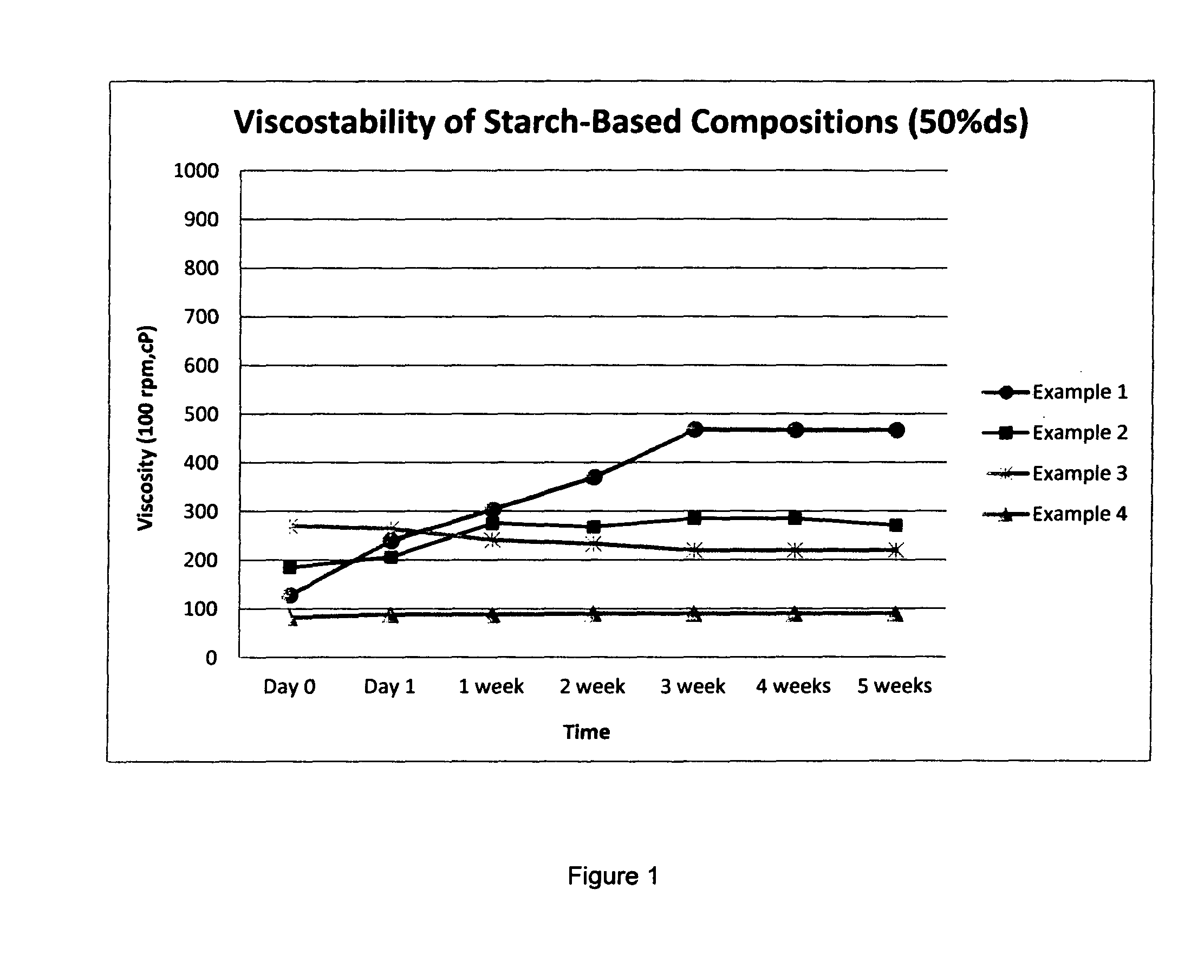Starch-based compositions for latex replacement
a technology of compositions and latex, applied in the field of starch-based compositions, can solve the problems of insufficient stability of 3 days, no-one has yet found an entirely satisfactory way of replacing synthetic latex polymers with starch, and the difference between starch and latex polymer is very different. , to achieve the effect of increasing the solubility of cold water
- Summary
- Abstract
- Description
- Claims
- Application Information
AI Technical Summary
Benefits of technology
Problems solved by technology
Method used
Image
Examples
example 1
Preparation of a Starch-Based Composition of the Invention in Open Batch System
[0063]Dextrin (a starch derivative), itaconic acid and persulfate are mixed together in an aqueous composition. The dextrin is present in an amount of 35-45% by weight based on the total weight of the composition. The itaconic acid is present in an amount of 5% by weight based on the total dry weight of dextrin. The pH of the composition is approximately 1.7. After 60 minutes mixing at 100 rpm the composition is heated to 80° C. for 3 to 5 hours before being cooled to 30° C. The heating results in cooking of the dextrin, simultaneously with polymerisation of the itaconic acid and modifying the dextrin. After cooling to 30° C., the composition is neutralized to pH 6-7 with sodium hydroxide. To the resulting composition is added 1.5% PAE (polyaminoamine-epichlorohydrin, as a wet-strength agent), and optionally glycerine and native starch. The result is a starch-based composition, with a dry solid content ad...
example 2
Preparation of a Starch-Based Composition of the Composition by Use of Jet Cooker
[0064]Dextrin, itaconic acid and persulfate are mixed together in an aqueous composition. The dextrin is present in an amount of 35-45% by weight based on the total weight of the composition. The itaconic acid is present in an amount of 5% based on the total dry weight of dextrin. The pH of the composition is approximately 1.7. After 15 minutes mixing at 100 rpm the composition is jet-cooked at 140° C. for 2 minutes and the paste maintained at 92-94° C. for 1 hour in a closed tank. The heating results in cooking and full dispersion of the dextrin, simultaneously with polymerisation of the itaconic acid and of modification of the dextrin. After cooling to 30° C., the composition is neutralized to pH 6-7 with sodium hydroxide. To the resulting composition is added 1.5% PAE (polyaminoamine-epichlorohydrin, as a wet-strength agent), and optionally glycerine and native starch. The result is a starch-based co...
example 3
Preparation of a Starch-Based Composition of the Invention by Enzymatic Conversion
[0065]Dextrin is suspended in water in an amount of 35-45% by weight. The resulting slurry is heated up to 80° C. and then an alpha-amylase (BAN 480L, Novozymes) is added to the suspension. The alpha-amylase is added in an amount of 500 ppm, based on the dextrin. After 30 minutes at 80° C. itaconic acid and persulfate are added to the aqueous composition. The itaconic acid is present in an amount of 5% by weight based on the total dry weight of dextrin. The pH of the composition is approximately 1.7. After 30 minutes mixing at 100 rpm, the composition is cooled to 30° C. The heating results in cooking of the starch by enzymatic conversion, simultaneously with polymerisation of the itaconic acid and modification of the dextrin. Additionally the acid inactivates the enzyme. After cooling to 30° C., the composition is neutralized to pH 6-7 with sodium hydroxide.
[0066]To the resulting composition is added ...
PUM
| Property | Measurement | Unit |
|---|---|---|
| Percent by mass | aaaaa | aaaaa |
| Fraction | aaaaa | aaaaa |
| Fraction | aaaaa | aaaaa |
Abstract
Description
Claims
Application Information
 Login to View More
Login to View More - R&D
- Intellectual Property
- Life Sciences
- Materials
- Tech Scout
- Unparalleled Data Quality
- Higher Quality Content
- 60% Fewer Hallucinations
Browse by: Latest US Patents, China's latest patents, Technical Efficacy Thesaurus, Application Domain, Technology Topic, Popular Technical Reports.
© 2025 PatSnap. All rights reserved.Legal|Privacy policy|Modern Slavery Act Transparency Statement|Sitemap|About US| Contact US: help@patsnap.com

